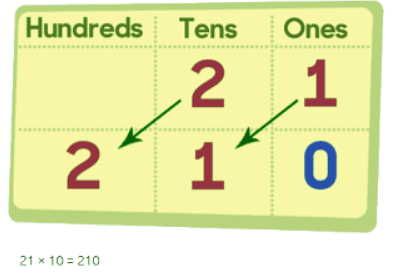Year 3 Exam > Year 3 Notes > Year 3 Mathematics > How to multiply and divide by 0, 1, 10 and 100
How to multiply and divide by 0, 1, 10 and 100 | Year 3 Mathematics PDF Download
Multiplying by 1, 10, or 100
- When you multiply any number by 1, the result remains the same.
- For example: 21 × 1 = 21
- Multiplying by 10 involves shifting all digits to the left, adding a zero at the end.
- For example: 21 × 10 = 210
- Multiplying by 100 requires shifting all digits two places to the left, adding zeros as needed.
- For example: 21 × 100 = 2100

Multiplying by 0
- Any number multiplied by 0 equals 0.
- For instance: 5 × 0 = 0
- Another example: 100 × 0 = 0
- Similarly, 9456 × 0 = 0
- Consider: What is 1,000,000 × 0?

Question for How to multiply and divide by 0, 1, 10 and 100Try yourself: What is 1,000,000 ? 0?View Solution
Dividing by 1, 10 or 100
- When you divide by 1, the result remains the same.
- Example: 21 ÷ 1 = 21
- When you divide by 10, shift all digits one place to the right.
- Example: 210 ÷ 10 = 21
- When you divide by 100, shift all digits two places to the right.
- Example: 2100 ÷ 100 = 21

The document How to multiply and divide by 0, 1, 10 and 100 | Year 3 Mathematics is a part of the Year 3 Course Year 3 Mathematics.
All you need of Year 3 at this link: Year 3
|
69 videos|67 docs|11 tests
|
FAQs on How to multiply and divide by 0, 1, 10 and 100 - Year 3 Mathematics
| 1. How do you count in multiples of 5? |  |
Ans. To count in multiples of 5, start with 5 and then add 5 to each subsequent number. For example, 5, 10, 15, 20, 25, and so on.
| 2. What is the significance of multiplying and dividing by 0 in mathematics? |  |
Ans. Multiplying any number by 0 results in 0, as anything multiplied by 0 is 0. Dividing by 0, however, is undefined in mathematics.
| 3. Why is multiplying and dividing by 1 considered the identity operation in mathematics? |  |
Ans. Multiplying any number by 1 results in the same number, as anything multiplied by 1 remains unchanged. Similarly, dividing any number by 1 also results in the same number, hence it is considered the identity operation.
| 4. How does multiplying and dividing by 10 affect the value of a number? |  |
Ans. Multiplying a number by 10 shifts the decimal point one place to the right, effectively increasing the value by a factor of 10. Dividing a number by 10 shifts the decimal point one place to the left, decreasing the value by a factor of 10.
| 5. What happens when you multiply and divide by 100 in mathematics? |  |
Ans. Multiplying a number by 100 shifts the decimal point two places to the right, effectively increasing the value by a factor of 100. Dividing a number by 100 shifts the decimal point two places to the left, decreasing the value by a factor of 100.

|
Explore Courses for Year 3 exam
|

|
Signup for Free!
Signup to see your scores go up within 7 days! Learn & Practice with 1000+ FREE Notes, Videos & Tests.
Related Searches
















